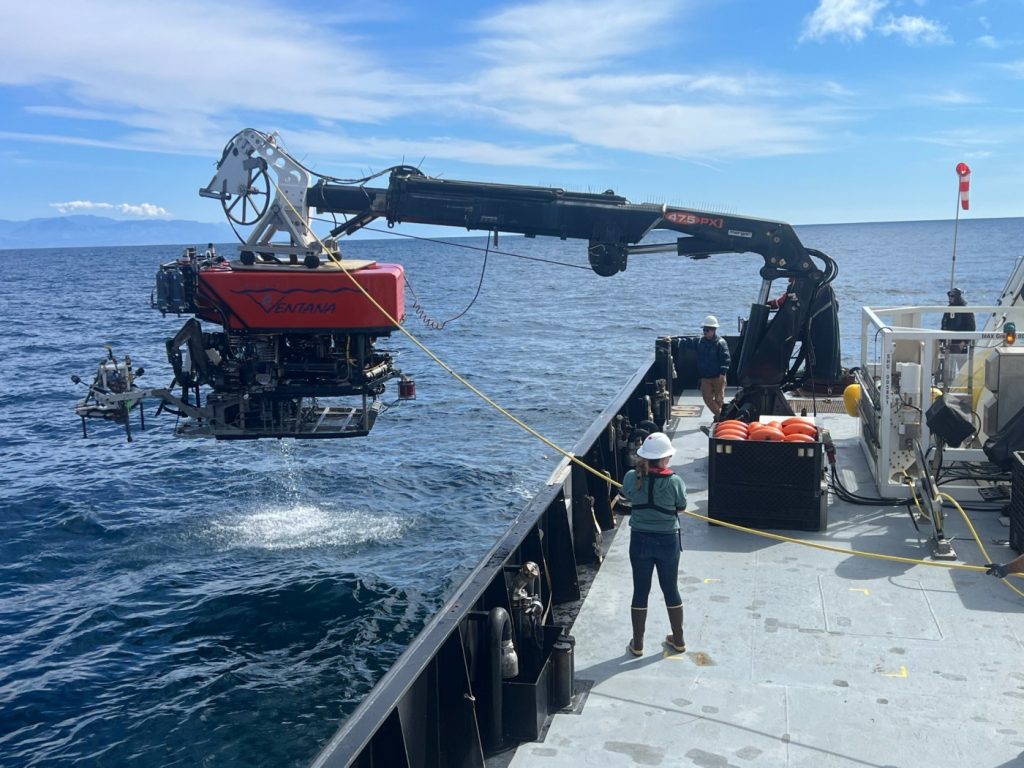Deep-sea coral restoration and research sites are being proposed to protect deep-sea habitats from bottom fishing gear in Monterey Bay National Marine Sanctuary.
“Throughout the world, we’ve been damaging deep-sea corals even before people really even thought about them,” said Andrew DeVogelaere, a research ecologist for NOAA’s Monterey Bay National Marine Sanctuary. “When people see them now, they’re beautiful and inspiring.”
On Thursday, the Pacific Fishery Management Council, which manages commercial, recreational, and tribal fisheries in Federal waters off of Washington, Oregon and California, will analyze the potential impacts of fishery closures to protect deep-sea corals from bottom contact gear at three potential sites – Sur Ridge, Año Nuevo Canyon, and Ascension Canyon.
At these depths, bottom contact gear could include traps or set longlines for sablefish, also known as black cod.
“Just like on land, there are some special places we don’t want to lose, like Yosemite or the Grand Canyon or beautiful areas from mining or from other sorts of human activities,” said Jim Barry, a senior scientist at MBARI. “So we set them aside to protect them.”
The proposed deep-sea coral research and restoration areas vary in size, with Sur Ridge being 36.64 square nautical miles, Año Nuevo Canyon being 6.5 square nautical miles, and Ascension Canyon being 2.96 square nautical miles. The depths in these areas range from 1,574 to 5,118 feet.
Fishing for black cod
A bubblegum coral (Paragorgia arborea) observed by MBARI’s remotely operated vehicle (ROV) Doc Ricketts at Sur Ridge at a depth of approximately 840 meters. (Photo courtesy of MBARI)
Black cod live in deep water ranging from 650 to 9,000 feet deep, and in California, set longlines are used to harvest them.
“It’s like a piece of rope with hooks every 18 inches on it, pre-baited and laid out over the ocean floor,” said Walter Deyerle, the captain of the F/V Sea Harvest IV. “It’s about a mile long with an anchor on each side that goes to a buoy.”
Two to three days a week, Deyerle catches black cod and distributes it.
“Last time, I fished down at Carmel Bay. It’s more localized for us smaller boats,” said Deyerle. “But a lot of the bigger boats go closer to the Ascension Canyon closures that are proposed.”
The Half Moon Bay and the Santa Cruz fishing fleet mainly fish around Ascension Canyon for black cod.
In 2022, California’s black cod commercial fishery was valued at over $6 million.
Black cod is known for its buttery, flakey meat and, locally, is one of the main fish used in fish and chips. Black cod caught in California is one of the “Best Choices” for sustainable seafood by the Monterey Bay Aquarium Seafood Watch.
“There might be some pushback from fishermen if we targeted areas for protection that were really key fishing locations for them,” said Barry. “But right now, we’re trying to find that sweet spot.”
Opposition
Related Articles
Sunflower sea stars are critically endangered, but can humans help the species rebound?
Rare hummingbird turns California family’s new yard into tourist attraction
Elephant seals are finding new places to call home
Awaiting the count – gray whales population has been declining
Why is a mellow skunk hanging around a Morgan Hill trail in broad daylight?
Many fishermen believe these protected areas would be just the start for future closures to restrict black cod fishing. Deyerle believes these closures are better than previous closures but struggles to believe they should start closing deepwater fishing grounds based on protecting coral.
“It really is a slippery slope. They start closing for coral and just expand, expand, expand, expand. Pretty soon, we won’t able to fish black cod around here,” said Deyerle.
The Santa Cruz Commercial Fisherman Association strongly opposes the proposal according to Tim Obert, a local commercial fisherman.
“If these closures take place, it will take away the very small amount of area that we as a fleet are allowed to fish and some of our only opportunity to make a living in the 2024 fishing season,” Obert stated in a written comment about the proposal. “With the closures to our commercial salmon season, and the closures for Quillback rockfish, this is one of the last areas we are allowed to fish … This closure of area would take away some, if not all, of the remaining opportunity, especially for smaller vessels that don’t have the opportunity to go to other states. Please do not close these areas. It’ll have huge impact on our local fishing communities.”
Other effects
Effects from humans from the surface can also harm the cold-water corals and sponges, which are incredibly fragile and can be easily damaged, not just from fishing gear.
“There was this incident that occurred where the sinking of a large dry dock took place,” said Karen Grimmer, the resource protection coordinator for NOAA’s Monterey Bay National Marine Sanctuary. “That was really what spurred the sanctuaries to look at ways to restore deep-sea coral as they were impacted by that incident.”
In 2016, a 528-foot-long dry dock was being towed from Puget Sound, Washington, to a recycling facility in Ensenada, Mexico.
While in transport, the dry dock sank in the northern part of Monterey Bay National Marine Sanctuary in under 4,000 feet of water, crushing sensitive deep-sea coral habitat.
“That started us to think about how, as sanctuaries, do we manage, mitigate, and restore areas that have been damaged by something like a large vessel or object,” said Grimmer.
The proposed areas are already protected from bottom trawling through Essential Fish Habitat protections put in place by the Council in 2020 with a collaborative process led by MBNMS working with trawl fishermen and environmental NGOs.
Research opportunities
Michael Burczynski (MBARI ROV pilot/technician) and Steve Litvin (MBARI senior research specialist) controlling the ROV, Ventana on the Rachel Carson’s control room at proposed restoration and research site, Sur Ridge. (Brian Phan – Herald Correspondent)
The Monterey Canyon, which starts in front of Moss Landing, is the largest submarine canyon on the Pacific Coast, giving researchers a unique opportunity.
“We do a lot of deep-sea research in this area because the ocean topography is perfect for it,” said DeVogelaere. “As we leave Moss Landing and before we finish our cup of coffee, we can be in 10,000 feet of water.”
Sur Ridge, one of the proposed sites, is only a 4-hour boat ride from Moss Landing, allowing researchers to do day expeditions to the site, collect data, deploy equipment, and be back before dinner.
“We have all of these experiments there to study corals in the deep sea, like no one else is doing, which is spectacular in itself,” said DeVogelaere.
The immense pressure, cold temperatures, along with the absence of light have made it difficult for researchers to study this unique ecosystem until scientists and engineers created Remotely Operated Vehicles (ROVs) to descend to the abyss without putting the human body in danger.
Easy access to the deep sea and ROVs allows researchers a unique opportunity to study deep-sea environments regularly.
One of the projects that researchers are trying to figure out is the changes in deep-sea coral behavior to the amount of food that is available throughout the year.
“One way we’ve tried to tackle that question is to put out timelapse cameras,” said Barry. “Where we have positioned a camera right in front of a coral, or a series of corals, and then basically take a little landscape shot every hour, for a year.”
These photos can show how the corals react to the seasonal abundance or lack of food in the deep.
“In the wintertime, they basically shut down and don’t feed at all, and their polyps are closed, kind of like a flower being closed,” said Barry.
Ongoing reserach, allows scientists to better understand a fragile ecosystem and how to protect them.
“Deep sea corals are like forests on land. In some ways, they’re like old-growth forests,” said Barry. “Because they grow very slowly, it takes them a long time to mature and develop communities just like you’d think about in a forest.”
Like forests, deep-sea corals provide habitat for various animal species, including commercially fished species, which can affect the health of fisheries.
Thursday, the Pacific Fishery Management Council is expected to decide on the number of areas to be protected.
“We should set some areas aside where we can do restoration and some research on these things,” said DeVogelaere. “And we’ll work with the fishermen where we can minimize the impact on your fishing if you don’t necessarily fish there. If this is a critical fishing spot, we won’t set it up there.”


